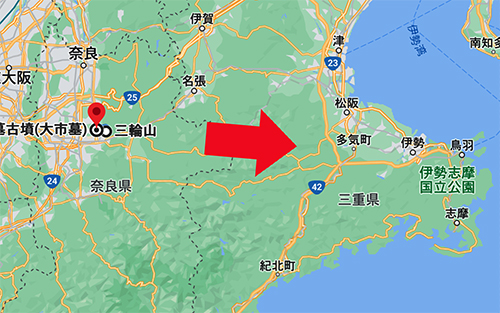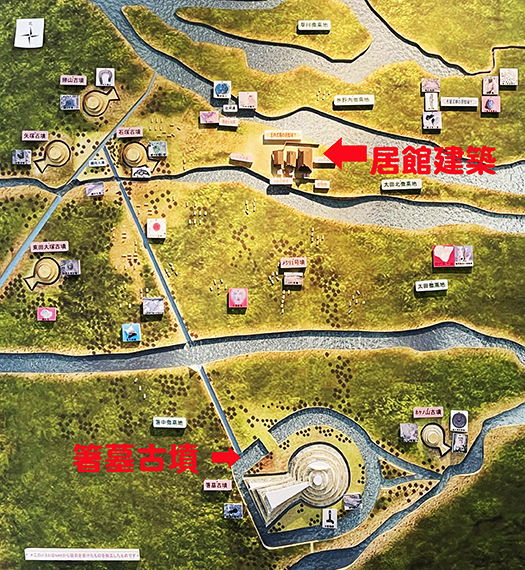

きのうのブログ記事を契機に「ムクムクと妄想が沸き立った」みたいなご意見投稿。
なので少しノリ気味に本日はそういう妄想の現段階を書いておこうと思います。
纏向遺跡の発掘進展によって古代史の手掛かりが増えてきている。
箸墓古墳はいわゆる古墳時代の最初を告げる前方後円墳。
実在の確かな天皇としての10代崇神帝の娘・巫女としての役割を果たしていた
倭迹迹日百襲姫命の墳墓とされるけれど、
最近は邪馬台国大和説の象徴として女王・卑弥呼と擬せられてきている。
この纏向遺跡の年代は100年代末から200年代初期の開始とされる。
考古的発掘からの年代特定。記紀での表記とは別に崇神帝はこの時期の人物だろう。
その娘とされる女性が前方後円墳の創始として葬られた必然性はなにか?

現地を見てみてわたし的には箸墓古墳と三輪山山頂の位置関係が気に掛かった。
で、こころみにその延長線を伊勢神宮まで延ばして考えて見たのが
上のGoogle Map地図になります。
東西南北の配置関係ではほぼ直線に位置が並ぶ。
古代王権とはなによりも農作業の指針を示す役割が第一だと思うので
暦や天体観測、測量的な部分は古代最高の「科学」として
ひとびとに正統性の根拠と認識されていた。その推測からすると
この箸墓古墳〜三輪山〜伊勢の方位的一致には根拠がありそうに思う。
古代の前方後円墳とはその頂きに王が立つことによって
人々に正統性認識を植え付けていく儀式の場であったとされる。
箸墓古墳の先に三輪山の山頂があり、さらに太陽がその背景として昇るとすれば、
古代の王権正統性刷り込みイベントとしては最適解だったように思うのです。
日の運行支配者という古代科学的正統性訴求。
そのような王権にとって、巫女的な役割の重要性も理解できる。
280-294年の時期に発行とされる魏志倭人伝に記された対邪馬台国外交訪問者の
中国人の目に、このような巫女女性が「女王」と認識されるのも理解できるし、
そういう認識に対し、古代王権としては否定する必要性もなかっただろう。
たぶん中国側の訪問者に対しては外交的最高レベルの安全保障の動機で接する。
<卑弥呼>による占術などの儀式を見せつける蓋然性も高い。
かれらに対して侵略は難しい強国であると認識させることが目的。
纏向遺跡の考古発掘からはこうした状況が年代的に合致してくる。
きのう触れたように、崇神帝期に伊勢神宮の初源的な社が纏向で創始され、
やがてそれが崇神帝の次代の垂仁帝期に伊勢に移転していった説が強い。
その移転に当たって当時の「科学知見」に基づいて方位をたどって
伊勢の地に勧請されていったものと推論できると思うのです。
いまのところ、根拠が明確ではない妄想・推論ではありますが、
歴史数寄としては現代科学に基づいた今後の解明に、大いに期待したい。
English version⬇
The Burial Site of Kofun’s Tomb of Chopstick Tomb and “Diplomacy” in Wei Wei’s Biography: Yamato Historical Testimony-14
Himiko is a “Miko of the Sun”? Intentional imprinting of the perception of a powerful “queen nation” motivated by diplomatic security operations against China. …
Yesterday’s blog post triggered a comment from someone who said, “I’m starting to get paranoid.
So I’m going to write about the current stage of my imagination today.
The progress of the excavation of the Sumimukai site has provided more and more clues to ancient history.
The Chopstick Tomb Tumulus is the first forward-rear round burial mound that marks the beginning of the so-called Kofun Period.
She served as the daughter and maiden of the 10th emperor of the Sun Goddess of the Sun Goddess as a real and certain emperor.
The tomb is believed to be the tomb of “Yamatotsuki Yamato,” the daughter and priestess of the 10th Emperor Takamatsu, who served as the actual emperor.
The tomb of the Queen Himiko has recently been likened to the Queen Himiko as a symbol of the Yamato theory of the Yamato kingdom of Yamataikoku.
The Makimuku site is dated to the late 100s or early 200s.
Dating from archaeological excavations. The emperor Chosin must have been a personage of this period, apart from the notation in the Chronicles.
What is the inevitability that a woman, who is believed to be his daughter, was buried as the founder of a forward-rear round burial mound?
After visiting the site, I was curious about the relationship between the Chopstick Tomb Tumulus and the summit of Mt.
I was curious about the location of the tombs and the summit of Mt.
The map is shown on the top of the Google Map.
The locations of the ancient kingships are almost aligned in a straight line in terms of east-west, north-south, and south-south.
I think that the ancient royal authority had the primary role of guiding agricultural work above all else, so it is not surprising that the Ise Shrines are located in a straight line.
The calendar, astronomical observation, and surveying are the best “science” of ancient times.
and surveying were recognized by the people as the basis of legitimacy. From this inference
I think there is a basis for the coincidence of the directions of the tombs of Chopstick Tomb, Mount Miwa, and Ise.
Ancient front-recessed circular tombs were designed to instill a sense of legitimacy in people by having a king standing at the top of them.
The ancient forward-rear burial mound is said to have been a ceremonial site where a king stood at the top to instill a sense of legitimacy in the people.
If the summit of Mt. Miwa is located beyond the tomb mound, and the sun rises in the background
It seems to me that this was the best solution for an ancient royal legitimacy imprinting event.
The ancient scientific legitimacy appeal of the ruler of the sun’s movement.
The importance of the priestess role for such a royal authority is also understandable.
of a diplomatic visitor to Yabataikoku, as recorded in the Wei Shihwaden, which is said to have been issued in the period 280-294.
It is also understandable that such a miko woman would be recognized as a “queen” in the eyes of the Chinese.
The ancient kingship would have had no need to deny such recognition.
Perhaps the Chinese would treat their visitors with the highest level of diplomatic security motivation.
<There is a high probability that they would show them rituals such as divination by Himiko.
The goal is to make them realize that they are a powerful nation that would be difficult to invade.
The archaeological excavations at the Makimuku ruins are chronologically consistent with this situation.
As I mentioned yesterday, the first shrine of the Ise Jingu Shrine was founded in Miamukai during the reign of Emperor Sujin.
It is strongly believed that the shrine was moved to Ise during the reign of the next Emperor Taruhito.
In the process of relocation, it is believed that the shrine was recommended to Ise by following the direction based on the “scientific knowledge” of the time.
I think it can be inferred that the shrine was moved to Ise by following the direction based on the “scientific knowledge” of the time.
Although it is a delusion and inference with no clear basis at this point
As a historian, I have great expectations for further clarification based on modern science.
Posted on 7月 6th, 2022 by 三木 奎吾
Filed under: 日本社会・文化研究, 歴史探訪







コメントを投稿
「※誹謗中傷や、悪意のある書き込み、営利目的などのコメントを防ぐために、投稿された全てのコメントは一時的に保留されますのでご了承ください。」
You must be logged in to post a comment.